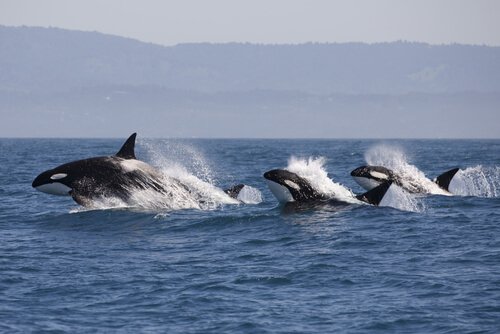How Dolphins Know When Orcas Are Around
Dolphins and whales can recognize the sounds that the most aggressive cetaceans on the planet make when they perform their hunting strategies, and they flee in fear.
This is how dolphins know when orcas are near
The orca is one of the most feared predators in the ocean. This mammal, which is one of the most intelligent animals on the planet, has an arsenal of complex hunting strategies that only a few animals can escape. The dolphin is one of the few animals that can detect when orcas are hunting nearby.
Hunting Strategies of the Top Marine Predator
A pack of orcas that are hunting is the last thing an animal would want to bump into the middle of the ocean. Their characteristic squeals almost resemble human voices. They are high pitched sounds that are used for communication, feeding, and reproduction.
Among the sounds that this species of cetacean emit, you can find:
- Echolocation clicks, brief pulses that they emit in sequences. They mainly use them for orientation and to locate prey around them. This type of ultrasound, which they emit at a frequency of between 4 and 18 kilohertz, also has certain social uses.
- Ultrasonic whistles are useful for interacting with different members of the pack. You could say that this is how orcas hold a conversation between other group members. They emit these whistles at an average frequency of 8.3 kilohertz, and they usually last for 1.8 seconds.
- Pulsed calls are the sounds that we could confuse with human squeals or screams. With a frequency of between 1 and 6 kilohertz, this type of ultrasound is mostly used during hunting. However, it’s also useful for communicating other orcas.
Orcas on the Hunt
The pulsed calls that have been mentioned above, are the only ones that humans can perceive. They are an essential strategy when orcas are on the hunt.
There are different subpopulations of these cetaceans. What makes these orcas different is due to the type of prey their diet consists of, which is based on the kind of strategies they perform while hunting.
For example, a pack that hunts herring uses a technique called carousel feeding. Orcas take turns going to the bottom of the herring bank and spinning around while blowing out air bubbles. They make sounds while terrorizing their prey by showing their white bellies. That way, the herring jump to the surface in desperation, where the rest of the pack is waiting.
How dolphins know when to swim for their lives
When it comes to dolphins, a team of scientists wanted to find out if dolphins would be able to understand the clicks, calls, and whistles of the orcas, because, in theory, orcas are just large dolphins.
To find out, the marine biologist team sailed about 50 miles offshore from the coast of North Carolina in order to see how local dolphins and whales responded to sounds made by orcas, which were played from the safety of the boats.
To check the effectiveness of the experiment, the scientists first played a series of everyday sounds that generated a normal response in the whale and dolphin population. When they played the orcas’ hunting call, all the animals immediately fled in the opposite direction of the sound.
“We found it incredible that a group of animals could respond so strongly to something that we were doing.”
With the data obtained by the main author Matthew Bowers, they were able to later recreate the other cetaceans’ answers and study their escape tactics.
They proved to be very different from one another’s. The dolphins fled without another thought. However, the whales formed a sort of a barrier to confront the orcas and defend themselves.
